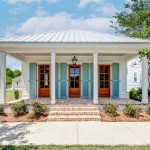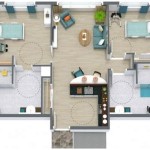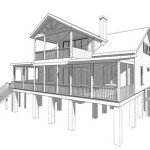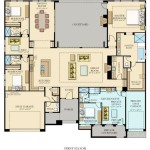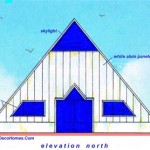Pole barn house design plans provide a framework for constructing a cost-effective and durable residential structure. These plans utilize vertical poles as the primary structural support, creating a spacious and open interior. Pole barn homes offer flexibility in design, allowing for customization and the incorporation of unique architectural elements. For instance, a pole barn house can feature a loft, a wrap-around porch, or a detached garage.
The versatility of pole barn house design plans extends to their adaptability to various terrains and climates. They are well-suited for both rural and suburban settings and can withstand extreme weather conditions, including high winds, heavy snowfall, and earthquakes. With their low-maintenance requirements and energy efficiency, pole barn homes offer a practical and eco-friendly housing solution.
In the following sections, we will delve deeper into the intricacies of pole barn house design plans, exploring their advantages, structural components, and the planning process involved in creating a customized home that meets your specific needs and aspirations.
Pole barn house design plans offer a myriad of benefits and considerations. Here are 9 important points to keep in mind:
- Cost-effective construction
- Spacious and open interiors
- Versatile design options
- Adaptable to various terrains
- Withstand extreme weather conditions
- Low-maintenance requirements
- Energy-efficient
- Customizable to specific needs
- Environmentally friendly
These factors make pole barn house design plans an attractive choice for those seeking a durable, affordable, and customizable home.
Cost-effective construction
Pole barn house design plans offer a cost-effective construction method compared to traditional stick-built homes. Here are four key factors that contribute to their affordability:
- Simplified foundation: Pole barns utilize a post-frame foundation system, which is less labor-intensive and requires less concrete than a traditional concrete slab or basement. This can result in significant savings on foundation costs.
- Efficient framing: The vertical poles used in pole barn construction provide the structural support for the walls and roof, eliminating the need for load-bearing interior walls. This simplified framing system reduces the amount of lumber required, further reducing construction costs.
- Open floor plan: Pole barn homes often feature open floor plans with fewer interior walls and partitions. This not only creates a spacious and airy living environment but also reduces the cost of materials and labor associated with constructing and finishing multiple rooms.
- Versatile exterior options: Pole barn homes can be clad with a variety of exterior materials, including metal, wood, or vinyl siding. These materials are relatively inexpensive and easy to install, providing flexibility and cost savings in the exterior design.
By incorporating these cost-saving measures, pole barn house design plans offer a budget-friendly option for homeowners seeking a durable and spacious home.
Spacious and open interiors
Pole barn house design plans offer spacious and open interiors that provide a sense of freedom and flexibility. Here are four key advantages of these expansive living spaces:
- Minimal interior walls: The post-frame construction method used in pole barn homes eliminates the need for load-bearing interior walls. This allows for the creation of large, open areas that can be customized to suit your specific needs and preferences.
- Soaring ceilings: Pole barn homes often feature high ceilings, which create a feeling of grandeur and spaciousness. These elevated ceilings also allow for the installation of mezzanines or lofts, providing additional living or storage space.
- Abundant natural light: The open design of pole barn homes allows for the incorporation of large windows and skylights. This maximizes natural light, creating a bright and airy living environment that reduces the need for artificial lighting.
- Flexible floor plan: The open interiors of pole barn homes provide flexibility in arranging furniture and creating different living zones. Whether you prefer a traditional living room layout or a more open-concept design, the spacious interior allows for customization and adaptability.
These advantages make pole barn house design plans an ideal choice for those seeking a home with a spacious, open, and flexible living environment.
Versatile design options
Pole barn house design plans offer a wide range of versatile design options that allow you to customize your home to suit your unique style and needs. Here are four key benefits of these flexible design features:
- Adaptable to various architectural styles: Pole barn homes can be designed to complement a variety of architectural styles, from rustic to modern. The exterior cladding, rooflines, and window designs can be disesuaikan to create a home that blends seamlessly with its surroundings or stands out as a unique expression of your personal taste.
- Flexible interior layouts: The open interiors of pole barn homes provide endless possibilities for interior layout and design. Whether you prefer a traditional floor plan with separate rooms or a more open-concept living space, the flexible design allows you to create a home that meets your specific needs and lifestyle.
- Expandability and additions: Pole barn homes can be easily expanded or modified in the future to accommodate growing families or changing needs. The post-frame construction method allows for the addition of new rooms, garages, or other structures without compromising the integrity of the existing building.
- Unique architectural features: Pole barn house design plans can incorporate unique architectural features such as lofts, mezzanines, and cathedral ceilings. These elements add visual interest and create additional living or storage space, allowing you to design a home that is both functional and aesthetically pleasing.
The versatility of pole barn house design plans empowers you to create a home that is tailored to your specific vision and requirements, ensuring that your living space reflects your unique personality and lifestyle.
Adaptable to various terrains
Pole barn house design plans are renowned for their adaptability to various terrains, making them suitable for construction in diverse geographical locations. The post-frame construction method employed in pole barns provides inherent advantages that allow them to withstand different soil conditions and topography.
The vertical poles used in pole barn construction are typically embedded deep into the ground, providing a stable foundation that can resist shifting soils and minimize the risk of structural damage. This makes pole barns an ideal choice for areas with unstable or uneven terrain, such as hillsides or slopes.
Additionally, the open design of pole barns allows for flexibility in foundation design. In areas with poor drainage or high water tables, pole barns can be constructed on elevated foundations or piers, raising the structure above the ground level to prevent moisture damage.
Furthermore, pole barn house design plans can be modified to accommodate specific terrain features. For instance, homes built on sloping land can incorporate stepped foundations or retaining walls to create level building pads. This adaptability ensures that pole barns can be constructed on challenging terrains without compromising structural integrity or aesthetic appeal.
The adaptability of pole barn house design plans to various terrains offers homeowners the freedom to build their dream homes in diverse geographical locations, regardless of soil conditions or topography.
Withstand extreme weather conditions
Pole barn house design plans are engineered to withstand extreme weather conditions, ensuring the safety and well-being of occupants. The robust construction methods and materials used in pole barns provide exceptional resistance to high winds, heavy snow loads, and seismic activity.
The post-frame construction system employed in pole barns utilizes vertical poles spaced at regular intervals, which are embedded deep into the ground. These poles serve as the primary structural support, transferring wind and snow loads directly to the foundation. The poles are typically made of pressure-treated wood or galvanized steel, providing resistance to rot, insects, and corrosion.
The exterior walls and roof of pole barns are typically clad with durable materials such as metal panels or wood siding. These materials are designed to withstand high winds and heavy precipitation, preventing moisture and structural damage. Additionally, the roof structure of pole barns often incorporates trusses or rafters spaced closely together, providing additional strength and support against snow loads.
In areas prone to seismic activity, pole barn house design plans can be modified to incorporate earthquake-resistant features. These may include reinforced foundations, shear walls, and flexible connections between structural components. By incorporating these measures, pole barns can withstand the lateral forces generated by earthquakes, minimizing the risk of structural failure.
The ability of pole barn house design plans to withstand extreme weather conditions makes them a reliable and safe housing option in areas with challenging climates. Homeowners can rest assured that their pole barn homes will provide protection and shelter during even the most severe weather events.
Low-maintenance requirements
Pole barn house design plans are renowned for their low-maintenance requirements, offering homeowners significant savings on upkeep and repairs over time. The durable materials and construction methods employed in pole barns contribute to their exceptional longevity and ease of maintenance.
- Durable exterior materials: Pole barns are typically clad with exterior materials such as metal panels or wood siding that are resistant to rot, moisture damage, and fading. These materials require minimal maintenance and can withstand harsh weather conditions, reducing the need for frequent repairs or replacements.
- Simplified roofing systems: Pole barn house design plans often incorporate simple roofing systems with metal panels or corrugated metal. These roofing materials are durable, weather-resistant, and require minimal maintenance compared to traditional asphalt shingles or tile roofs.
- Open interiors: The open interior design of pole barns eliminates the need for load-bearing interior walls, reducing the likelihood of structural issues or damage. This simplified interior requires less maintenance and allows for easy cleaning and repairs.
- Pest resistance: The pressure-treated wood or galvanized steel used in pole barn construction is resistant to pests such as termites and carpenter ants. This reduces the risk of structural damage and the need for costly pest control treatments.
The low-maintenance requirements of pole barn house design plans make them an ideal choice for homeowners seeking a durable and hassle-free living space. With minimal upkeep, pole barns offer lasting value and peace of mind.
Energy-efficient
Pole barn house design plans prioritize energy efficiency, incorporating various features and techniques to minimize energy consumption and reduce utility costs for homeowners. One key aspect of energy efficiency in pole barns is the use of insulated exterior walls and roofing systems. Insulation materials such as fiberglass, cellulose, or spray foam are installed within the walls and roof cavities, creating a thermal barrier that prevents heat loss during winter and heat gain during summer.
Another important factor contributing to the energy efficiency of pole barn homes is the incorporation of energy-efficient windows and doors. Windows with double or triple glazing, low-emissivity coatings, and tight seals help reduce heat transfer and minimize air leakage. Similarly, well-insulated doors with weatherstripping and thresholds prevent drafts and heat loss.
The open design of pole barn homes also contributes to their energy efficiency. The absence of interior load-bearing walls allows for natural air circulation throughout the living space. This passive ventilation helps regulate indoor temperatures and reduces the need for mechanical heating or cooling systems.
Additionally, pole barn house design plans can incorporate renewable energy sources such as solar panels or geothermal systems. Solar panels installed on the roof can generate electricity from sunlight, reducing reliance on the grid and lowering energy bills. Geothermal systems utilize the stable underground temperatures to provide heating and cooling, offering a sustainable and energy-efficient alternative to traditional HVAC systems.
By integrating these energy-efficient features, pole barn house design plans offer homeowners a comfortable and sustainable living environment while minimizing their energy consumption and environmental impact.
Customizable to specific needs
Pole barn house design plans offer a high degree of customization, allowing homeowners to create living spaces that perfectly align with their unique requirements and preferences. This flexibility extends to various aspects of the home’s design, including:
- Layout and floor plan: Pole barn homes can be designed with a variety of floor plans to accommodate different family sizes and lifestyles. Whether you prefer a traditional layout with separate rooms or a more open-concept design, the post-frame construction method allows for maximum flexibility in configuring the interior space.
- Exterior design: The exterior appearance of a pole barn home can be customized to complement various architectural styles and personal tastes. From rustic wood siding to modern metal panels, a wide range of cladding options are available to create a unique and visually appealing facade.
- Interior finishes: The interior finishes of a pole barn home can be tailored to reflect the homeowner’s style and preferences. This includes the choice of flooring, wall coverings, cabinetry, and fixtures, allowing for a personalized and comfortable living environment.
- Functional features: Pole barn house design plans can incorporate specialized functional features to meet specific needs. For example, homes can be designed with attached garages, workshops, or additional living spaces to accommodate hobbies, recreational activities, or extended family.
The customizable nature of pole barn house design plans empowers homeowners to create a truly personalized living space that meets their specific requirements and enhances their quality of life.
Environmentally friendly
Pole barn house design plans prioritize environmentally friendly construction practices and materials, contributing to a sustainable and eco-conscious living environment. Here are four key points that highlight the environmental benefits of pole barns:
- Sustainable materials: Pole barn construction utilizes renewable and sustainable materials such as wood and steel. Wood is a biodegradable and recyclable resource, while steel is highly durable and can be recycled multiple times. By incorporating these materials, pole barns minimize their environmental impact and promote resource conservation.
- Reduced waste: The post-frame construction method used in pole barns generates minimal waste compared to traditional stick-built homes. The pre-cut and pre-engineered components reduce the amount of materials required on-site, minimizing waste and promoting efficient use of resources.
- Energy efficiency: As discussed earlier, pole barn house design plans incorporate energy-efficient features such as insulation, energy-efficient windows and doors, and passive ventilation. By reducing energy consumption, pole barns minimize their carbon footprint and contribute to a greener environment.
- Disaster resilience: Pole barns are engineered to withstand extreme weather conditions, including high winds, heavy snow loads, and earthquakes. This resilience reduces the risk of damage or destruction during natural disasters, minimizing the need for repairs and replacements and promoting long-term sustainability.
The environmentally friendly aspects of pole barn house design plans make them an attractive choice for homeowners seeking a sustainable and responsible living space that minimizes their ecological impact.










Related Posts

